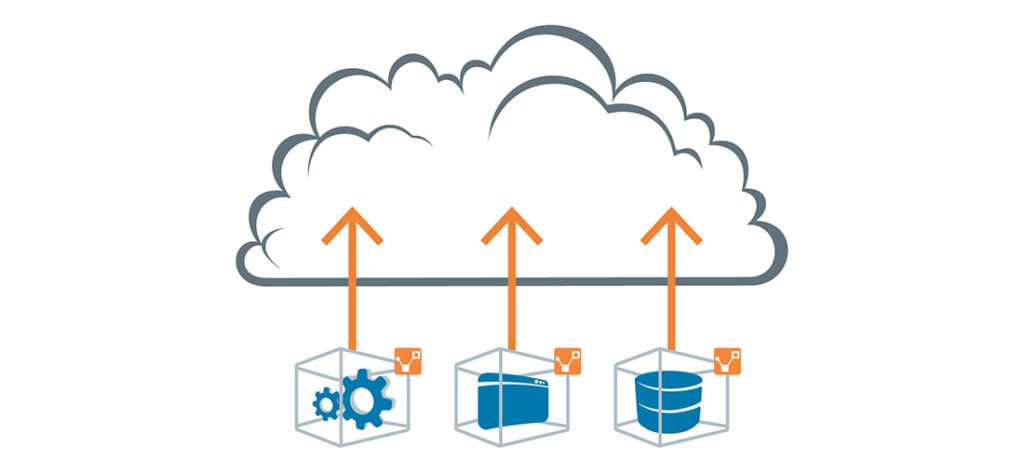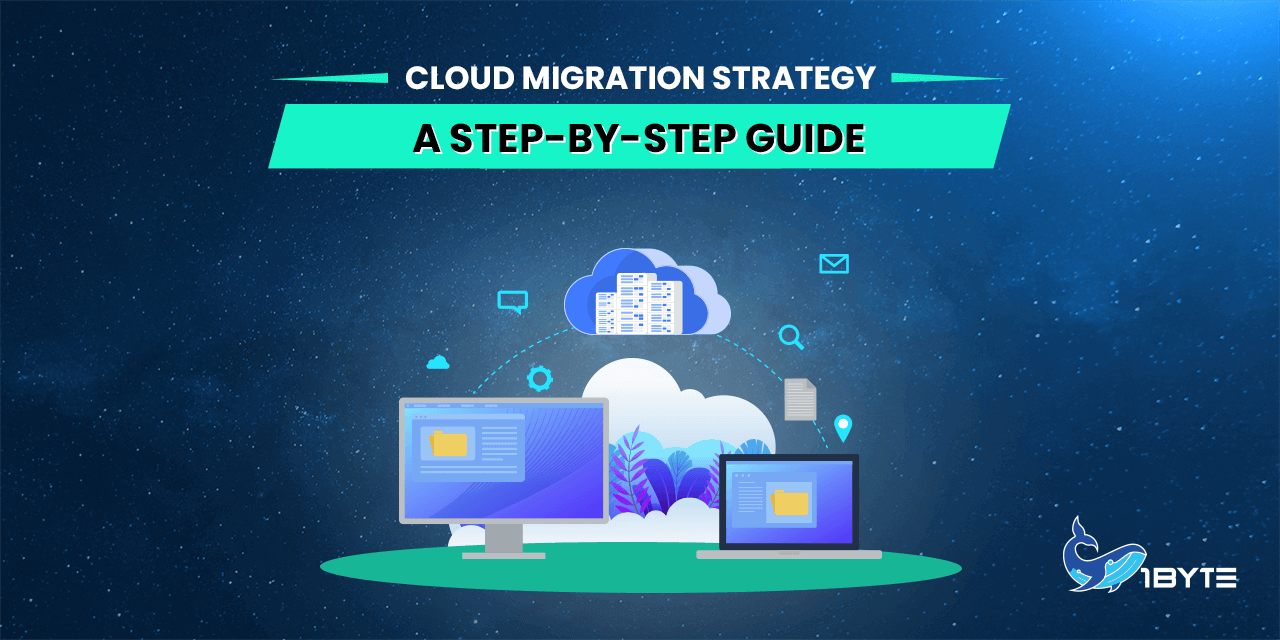Do you want to move to the cloud but don’t know where to begin? No need to worry, we’ve got you prepared with our step-by-step cloud migration strategy guide! Moving your company to the cloud can be a daunting endeavor, but with the correct approach and planning, you can achieve a smooth transition with little disruptions. The increased requirement for agility, scalability, and cost savings is driving this trend. We’ll cover all you need to know about developing a successful cloud migration strategy, from assessment and planning to post-migration activities and best practices, in this article. Let’s get this party started!
An Overview
Before we go into the specifics of cloud migration strategy, let’s clarify what cloud migration is and why it matters.
FURTHER READING: |
| 1. How To Mount (Upgrade) Storage on 1Byte Cloud Server - Intro |
| 2. How To Mount (Upgrade) Storage on 1Byte Cloud Server – CentOS |
| 3. VoIP Advantages and Disadvantages for Business |
What is Cloud Migration?
The process of migrating your company’s digital assets, such as databases, IT resources, services, and apps, from on-premises servers to a cloud-based architecture is known as cloud migration. Essentially, you are moving your data and processes from a local server to a remote facility maintained by an external supplier and accessible via the internet.
Cloud migration entails a variety of processes that must be completed in a systematic manner. The first step is to evaluate your business case, including your budget and IT requirements, and then choose the best cloud provider for you. Following that, you should decide which applications to migrate and devise a strategy for safely transferring your data to the cloud.
The following phase is to determine which cloud services will support or reproduce the capabilities of your present infrastructure, as well as to design the new application and infrastructure architecture. This includes deciding on the safe data migration paths and connecting the new infrastructure with your existing systems.

The benefits of cloud migration include speed and agility, as cloud services enable businesses to acquire storage space or fresh merchandise in a matter of days or even hours. Furthermore, cloud migration has the potential to lessen the operational burden of running and maintaining hardware and software.
However, it is vital to highlight that cloud migration is a large-ticket item, so make sure your funds are sufficient to see the project through. You must also consider the potential security concerns associated with transferring sensitive data to the cloud. As a result, it is critical to create a comprehensive cloud migration strategy that addresses these concerns while also meeting your company goals.
The Importance of Having a Cloud Migration Strategy
A cloud migration strategy is required when transferring your organization to the cloud. A well-planned and structured cloud migration strategy can provide various benefits to your business, including cost savings, more flexibility, innovation, enhanced dependability, speed, and storage capacity. You may find the workload being migrated, mirror current functionality in the cloud data center, test that everything works as expected, and put everything live on the cloud data center by following a step-by-step guidance. A cloud migration strategy is critical because it can minimize the operational load of running and maintaining hardware and software, resulting in better digital business and a faster time to value.
The value of having a cloud migration plan stems from the fact that it helps to streamline the migration process, reducing the likelihood of any accidents or complications occurring during the process. Businesses can plan their migration to ensure that everything goes smoothly and that the process does not impede their day-to-day operations. Businesses can save money and resources by ensuring that they are not moving anything superfluous by having a comprehensive grasp of the workload being moved. Furthermore, by duplicating current functionality in the cloud data center, organizations can assure that their operations will not be disrupted.
Furthermore, having a cloud migration strategy can assist firms in ensuring that all of the elements work as anticipated and that everything is functioning properly before bringing everything live to the cloud data center. Businesses can verify everything before the final cut-over by validating the migration, lowering the likelihood of complications following the move.
The Numbers
Cloud migration is a widespread trend among enterprises all over the world. According to Flexera, 87% of businesses have a hybrid cloud strategy in place, while 93% use a multi-cloud strategy. In terms of costs, 50% of businesses spend between $1.2 million and $2.4 million per year, with the remaining 38% spending more than $2.4 million. Azure, Microsoft’s cloud computing platform, is a popular cloud migration choice, accounting for 16.8% of the global cloud market. In contrast, AWS is the most popular cloud provider, dominating the cloud computing market. The cloud migration services market is estimated to reach USD 448.34 billion by 2026, at a CAGR of 28.89% from 2021 to 2026.
There are four major processes involved in migrating to the cloud: finding the workload to be transferred, establishing the cloud infrastructure, confirming that all elements perform as expected, and cutting over by transferring the job into the cloud. This process can be difficult, but it is required for a successful relocation.
The 4-Step Cloud Migration Strategy
Cloud migration is not a simple procedure. It necessitates meticulous planning, implementation, and management. This is where a four-step cloud migration approach comes into play. The approach outlined here assists firms in moving their IT infrastructure to the cloud in a systematic and efficient manner. In this section, we will go over the four processes in detail, offering insights and ideas to help you seamlessly move your organization to the cloud.
Assessment and Planning
The initial steps in an effective cloud migration strategy are assessment and planning. To understand what you require from the cloud, you must first establish your organization’s requirements, goals, and challenges. Begin by evaluating your current IT infrastructure to establish what you have, what you must preserve, and what you can get rid of. This research will assist you in determining which cloud service provider (CSP) is the greatest fit for your requirements.
After you’ve determined your requirements, it’s time to plan your migration. Timelines, budgets, and any resources required for the relocation should all be included in this strategy. In this planning step, it is also critical to consider security and compliance concerns. From the first assessment through post-migration testing, your migration plan should be comprehensive.
It’s also vital to prioritize your migration strategy to guarantee that your most critical applications and data are moved first. This reduces disruption to your business processes and mitigates hazards. Furthermore, by prioritizing the migration, you can concentrate on the most crucial aspects of the migration first.
To ensure that everyone is on the same page, include all important stakeholders in the planning process. IT teams, business leaders, and any third-party vendors involved in the move are all included. A successful move requires effective communication and collaboration.
Pre-Migration Preparation
Pre-migration planning is essential for having a seamless cloud migration procedure. This process entails identifying the apps and data that will be transferred to the cloud, evaluating their compatibility with the cloud environment, and determining any necessary changes that must be done prior to the migration.
The first stage in cloud migration planning is determining which applications and data will be moved to the cloud. This necessitates an in-depth examination of your current IT environment, including hardware, software, and data storage. Once you’ve determined what needs to be moved, you can start planning the actual migration.
Before migrating your applications and data to the cloud, you must guarantee that they are cloud-compatible. This entails determining whether any changes are required to ensure that they can run efficiently on the cloud. For example, to take advantage of the cloud’s scalability and flexibility, programs may need to be changed or upgraded.
It is also critical to verify that your data is appropriately protected before migrating. This includes auditing your data security policies and putting in place any necessary safeguards to protect your data during the migration process. Encrypting your data, creating access controls, and ensuring that all data is backed up are all part of the process.
Another critical part of pre-migration planning is ensuring that your IT crew is properly prepared to work in a cloud environment. This includes cloud-specific technology training as well as best practices for managing cloud-based applications and data.
Data Migration
Data transfer is an important part of your cloud migration strategy. This stage entails transferring data from your present system to the cloud. To avoid data loss or corruption, the data migration process can be complex and requires careful preparation and execution.

Before migrating data, it is critical to examine the data to be transferred and select the optimal method of transfer. This may entail employing cloud-based migration tools or collaborating with a third-party provider to ensure a smooth transition. Before carrying out the actual migration, the transfer process should be tested to confirm its success.
Post-Migration Activities
Following the completion of the data migration, it is critical to execute post-migration actions to ensure that everything is working smoothly. These activities include cloud testing, monitoring, and optimization.
To begin, testing must be performed to check that all data has been correctly migrated and that the applications are working properly in the new cloud environment. This procedure entails executing a series of tests to ensure that the applications are working and to detect any issues that may have developed during the migration process.
Following that, monitoring must be implemented to track the performance of the applications as well as the entire cloud environment. This monitoring entails gathering and analyzing data on the performance of the cloud environment, such as resource utilization, response times, and user activity. By monitoring the cloud environment, any difficulties that may emerge can be identified and corrected as soon as possible.
Finally, optimization must be performed on a continuous basis to fine-tune the performance of the cloud environment. This procedure entails altering the setup of the cloud environment, such as adjusting the resources allotted to applications and tweaking the network settings. It is possible to ensure that the cloud environment is functioning at top performance and providing the best possible user experience by continuously improving it.
Challenges and Risks
When it comes to cloud migration, there will inevitably be problems and risks. In this final section, we will look at some of the most frequent challenges that businesses experience while migrating to the cloud, as well as ways for overcoming them. It’s critical to identify these problems and dangers ahead of time so you can plan for them and avoid potential setbacks that could harm your company’s productivity and profitability. So, let’s take a look at the problems and hazards of cloud migration and how to reduce their impact on your migration strategy.
Common challenges in cloud migration
Migrating to the cloud may be difficult, and businesses must be aware of the possible stumbling blocks that may occur during the process. Here are some of the most typical issues that businesses experience while migrating to the cloud:
- Worries about security: When shifting to the cloud, security threats and data breaches are important worries. Significant financial losses, regulatory fines, and reputational damage can arise from data breaches.
- Issues with compatibility: Businesses must verify that their existing software programs, data formats, and infrastructure are cloud-compatible. Incompatibilities can result in poor performance, data loss, and system downtime.
- Data migration can be complicated and time-consuming, especially if the data is spread across multiple locations and formats. Data loss or corruption due to migration mistakes can disrupt business operations.
- Cost management: Cloud migration can be costly, and firms must carefully control their expenditures to minimize unforeseen spending. To manage the relocation process, some organizations may need to invest in new infrastructure or recruit additional personnel.
- Lack of expertise: Cloud migration necessitates specialist knowledge, which many organizations may lack. Businesses that lack adequate experience may make mistakes that result in performance concerns, security vulnerabilities, and other issues.
- Downtime: Cloud migration can disrupt business operations by causing downtime. Businesses must plan for downtime and reduce its impact on operations.
It is critical to recognize potential difficulties and have a plan in place to address them. This can entail performing a complete risk assessment, creating a precise migration plan, and collaborating with skilled cloud migration professionals.
Risks involved in cloud migration
Cloud migration has considerable risks, and it is critical to consider these potential concerns while building your cloud migration strategy. One of the most serious dangers is data loss or corruption during the migration procedure. This can occur if data is not properly backed up before the migration or if there are issues with the migration itself. The prospect of a security breach is another important concern. Businesses must verify that their security procedures are enough to safeguard their data and systems from potential assaults when migrating to the cloud. Any vulnerabilities must be identified and addressed prior to the move.

Another major danger is incompatibility between the new cloud environment and existing IT infrastructure. This can cause problems with software and apps that are incompatible with the cloud environment. This can lead to a large amount of downtime and lost production. As a result, before moving, it is critical to confirm that all systems and applications are compatible with the new cloud environment.
Finally, for enterprises, the expense of cloud migration might be a considerable risk. Migrating to the cloud may be expensive, and expenses can quickly spiral out of control without careful planning. This can lead to organizations spending significantly more than they expected, potentially jeopardizing their financial viability. To reduce this risk, firms should plan and budget for cloud migration carefully, accounting for all potential costs such as migration, training, and continuing maintenance.
Strategies to mitigate risks and challenges
While cloud migration can be intimidating, there are numerous solutions available to reduce risks and problems.
- Plan your move: Proper planning can help you avoid missing any important milestones in the migrating process. To keep track of the migration progress, create a checklist and timeline of actions, including milestones and deadlines.
- Before transferring, perform a thorough examination of your current infrastructure to identify any barriers and compatibility difficulties. This review should involve an examination of your application’s security and compliance needs, as well as an examination of its architecture and data structure.
- Choose a cloud provider that suits your individual needs and expectations, taking into account elements such as cost, reliability, scalability, and performance.
- Train your staff: Ensure that your team is well-versed in the cloud platform and its tools. This can help to avoid mistakes and ensure a seamless relocation procedure.
- Thoroughly test your applications and systems before going live to ensure that everything works as it should. This can aid in identifying and addressing concerns before they become serious difficulties.
- Have a backup plan in place: Even with the finest planning and preparedness, unexpected problems might happen throughout the relocation process. Prepare a plan for reverting to your former infrastructure if necessary.
By implementing these techniques, you may reduce the risks and problems connected with cloud migration, ensuring a smooth and successful transfer to the cloud.
Leverage 1Byte’s strong cloud computing expertise to boost your business in a big way
1Byte provides complete domain registration services that include dedicated support staff, educated customer care, reasonable costs, as well as a domain price search tool.
Elevate your online security with 1Byte's SSL Service. Unparalleled protection, seamless integration, and peace of mind for your digital journey.
No matter the cloud server package you pick, you can rely on 1Byte for dependability, privacy, security, and a stress-free experience that is essential for successful businesses.
Choosing us as your shared hosting provider allows you to get excellent value for your money while enjoying the same level of quality and functionality as more expensive options.
Through highly flexible programs, 1Byte's cutting-edge cloud hosting gives great solutions to small and medium-sized businesses faster, more securely, and at reduced costs.
Stay ahead of the competition with 1Byte's innovative WordPress hosting services. Our feature-rich plans and unmatched reliability ensure your website stands out and delivers an unforgettable user experience.
As an official AWS Partner, one of our primary responsibilities is to assist businesses in modernizing their operations and make the most of their journeys to the cloud with AWS.
Conclusion
As 1Byte, Cambodia’s largest cloud firm and an official AWS partner, we hope this guide has given you a thorough grasp of the procedures and problems involved in a cloud migration strategy. Migrating to the cloud is a complex process, but with the correct methodology, you can reduce risks while reaping the benefits of increased performance, scalability, and cost-effectiveness.
Remember that each organization’s cloud migration journey is unique, and a customised solution that meets your individual objectives is crucial. Understanding your current infrastructure, planning for potential issues, and developing a staged approach that assures little disruption to your business operations are all part of this process.
We understand the problems of cloud migration at 1Byte, and we have the knowledge to assist you migrate to the cloud with confidence. Our certified cloud experts can walk you through the entire process, from strategy to deployment and ongoing maintenance.
If you’re thinking about a cloud migration strategy, contact 1Byte now for a consultation and find out how we can help you reach your business goals by leveraging the power of the cloud.

